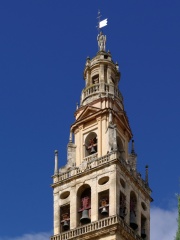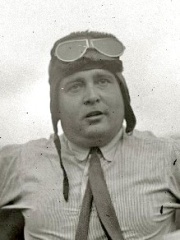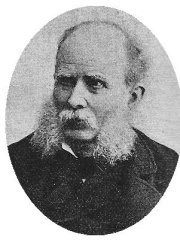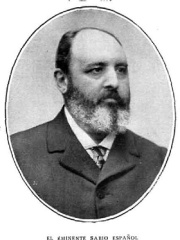



The Most Famous
INVENTORS from Spain
Top 4
The following people are considered by Pantheon to be the most legendary Spanish Inventors of all time. This list of famous Spanish Inventors is sorted by HPI (Historical Popularity Index), a metric that aggregates information on a biography's online popularity.

1. Abbas ibn Firnas (810 - 887)
With an HPI of 75.27, Abbas ibn Firnas is the most famous Spanish Inventor. His biography has been translated into 53 different languages on wikipedia.
Abū al-Qāsim ʿAbbās ibn Firnās ibn Wardās al-Tākurunnī (Arabic: أَبُو ٱلْقَاسِمِ، عَبَّاسُ بْنُ فِرْنَاسِ بْنِ وَرْدَاسَ ٱلتَّاكُرُنِّيُّ; c. 809/810 – 887 CE), known as ʿAbbās ibn Firnās (Arabic: عَبَّاسُ بْنُ فِرْنَاسٍ) was an Andalusi polymath: an inventor, astronomer, physician, chemist, engineer, Andalusi musician, and Arabic-language poet. He was reported to have experimented with unpowered flight. Ibn Firnas made various contributions in the field of astronomy and engineering. He constructed a device which indicated the motion of the planets and stars in the Universe. In addition, Ibn Firnas came up with a procedure to manufacture colourless glass and made magnifying lenses for reading, which were known as reading stones.

2. Juan de la Cierva, 1st Count of la Cierva (1895 - 1936)
With an HPI of 61.70, Juan de la Cierva, 1st Count of la Cierva is the 2nd most famous Spanish Inventor. His biography has been translated into 29 different languages.
Juan de la Cierva y Codorníu, 1st Count of la Cierva ([ˈxwan de la ˈθjeɾβaj koðoɾˈni.u]; 21 September 1895 – 9 December 1936), was a Spanish civil engineer, pilot and a self-taught aeronautical engineer. His most famous accomplishment was the invention in 1920 of a rotorcraft called Autogiro, a single-rotor type of aircraft that came to be called autogyro in the English language. In 1923, after four years of experimentation, De la Cierva developed the articulated rotor, which resulted in the world's first successful flight of a stable rotary-wing aircraft, with his C.4 prototype.

3. Narcís Monturiol (1819 - 1885)
With an HPI of 61.31, Narcís Monturiol is the 3rd most famous Spanish Inventor. His biography has been translated into 26 different languages.
Narcís Monturiol i Estarriol (Catalan pronunciation: [nəɾˈsiz muntuɾiˈɔl i əstəriˈɔl]; 28 September 1819 – 6 September 1885) was a Spanish lawyer, artist, journalist, newspaper publisher and engineer born in Figueres, Catalonia. He was the inventor of the first air-independent and combustion-engine-driven submarine.

4. Leonardo Torres y Quevedo (1852 - 1936)
With an HPI of 57.50, Leonardo Torres y Quevedo is the 4th most famous Spanish Inventor. His biography has been translated into 20 different languages.
Leonardo Torres Quevedo (Spanish: [leoˈnaɾðo ˈtores keˈβeðo]; 28 December 1852 – 18 December 1936) was a Spanish civil engineer, mathematician and inventor, known for his numerous engineering innovations, including aerial trams, airships, catamarans, and remote control. He was also a pioneer in the field of computing and robotics. Torres was a member of several scientific and cultural institutions and held such important positions as the seat N of the Real Academia Española (1920–1936) and the presidency of the Spanish Royal Academy of Sciences (1928–1934). In 1927 he became a foreign associate of the French Academy of Sciences. His first groundbreaking invention was a cable car system patented in 1887 for the safe transportation of people, an activity that culminated in 1916 when the Whirlpool Aero Car was opened in Niagara Falls. In the 1890s, Torres focused his efforts on analog computation. He published Sur les machines algébriques (1895) and Machines à calculer (1901), technical studies that gave him recognition in France for his construction of machines to solve real and complex roots of polynomials. He made significant aeronautical contributions at the beginning of the 20th century, becoming the inventor of the non-rigid Astra-Torres airships, a trilobed structure that helped the British and French armies counter Germany's submarine warfare during World War I. These tasks in dirigible engineering led him to be a key figure in the development of radio control systems in 1901–05 with the Telekine, which he laid down modern wireless remote-control operation principles. From his Laboratory of Automation created in 1907, Torres invented one of his greatest technological achievements, El Ajedrecista (The Chess Player) of 1912, an electromagnetic device capable of playing a limited form of chess that demonstrated the capability of machines to be programmed to follow specified rules (heuristics) and marked the beginnings of research into the development of artificial intelligence. He advanced beyond the work of Charles Babbage in his 1914 paper Essays on Automatics, where he speculated about thinking machines and included the design of a special-purpose electromechanical calculator, introducing concepts still relevant like floating-point arithmetic. British historian Brian Randell called it "a fascinating work which well repays reading even today". Subsequently, Torres demonstrated the feasibility of an electromechanical analytical engine by successfully producing a typewriter-controlled calculating machine in 1920. He conceived other original designs before his retirement in 1930, some of the most notable were in naval architecture projects, such as the Buque campamento (Camp-Vessel, 1913), a balloon carrier for transporting airships attached to a mooring mast of his creation, and the Binave (Twin Ship, 1916), a multihull steel vessel driven by two propellers powered by marine engines. In addition to his interests in engineering, Torres also stood out in the field of letters and was a prominent speaker and supporter of Esperanto.
People
Pantheon has 4 people classified as Spanish inventors born between 810 and 1895. Of these 4, none of them are still alive today. The most famous deceased Spanish inventors include Abbas ibn Firnas, Juan de la Cierva, 1st Count of la Cierva, and Narcís Monturiol.
Deceased Spanish Inventors
Go to all RankingsAbbas ibn Firnas
810 - 887
HPI: 75.27
Juan de la Cierva, 1st Count of la Cierva
1895 - 1936
HPI: 61.70
Narcís Monturiol
1819 - 1885
HPI: 61.31
Leonardo Torres y Quevedo
1852 - 1936
HPI: 57.50
Overlapping Lives
Which Inventors were alive at the same time? This visualization shows the lifespans of the 3 most globally memorable Inventors since 1700.

